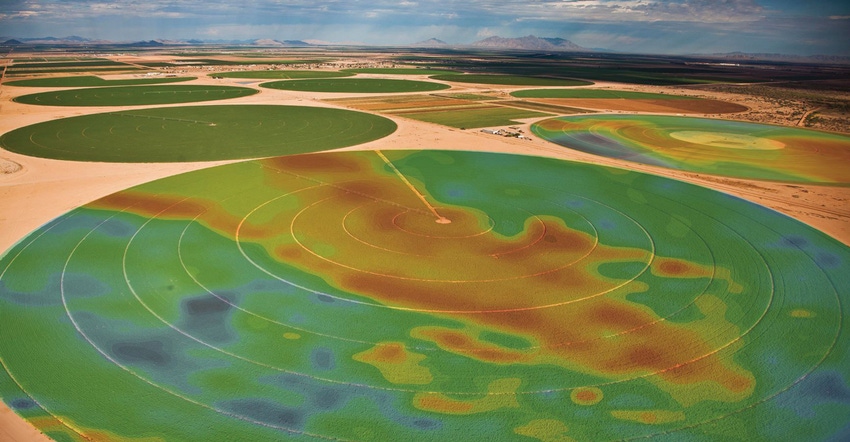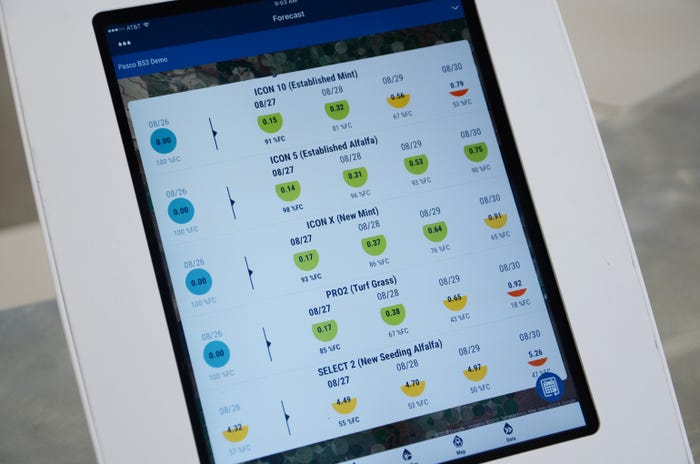September 24, 2018

Irrigation control has long been part of the picture for most operations. The ability to start and stop a pivot with your cellphone isn’t news; but having an expert system on board to help manage irrigation needs most efficiently is the newest innovation. Valley Irrigation rolled out a range of new tools aimed at enhancing farm water use during the fall farm show season.
Variable-rate irrigation and the concept of individually controlling sprinkler heads along the length of the pivot for enhanced water management aren’t new ideas. They’ve been at work for a few years in the irrigation industry. Valley is now offering an improved version of VRI-iS software, providing innovations in controlling those sprinkler heads.
The new software, paired with hardware components, allows users to develop prescriptions using shape files, and draw polygons of zones to be controlled at an individual sprinkler level. Those prescriptions can then be sent to the Valley Icon panels using AgSense and the built-in Icon Link, or to Pro2 panels using Valley CommanderVP.
Craig Bell, Valley product manager, explained that now it will be possible for customers to control variable-rate application through a web-based application. “And the system integrates with our AgSense smart irrigation solution,” he added. “You can develop a prescription based on the time of year, or specific goals, and send that to your panel through the AgSense system.”
“This system allows for easy setup of the variable-rate script,” Bell explained. Fields are divided into sectors every 0.1 degree for precision. “And you can set up the system to change application rates or turn off individual sprinklers during the pass,” he added.

SCHEDULING ENHANCEMENT: Valley offers a software-based irrigation scheduling tool that can improve how farmers water their crops. The system uses a proprietary model that can offer guidance based on weather and crop stress in-season. The display offers green, yellow and red indicators to help manage water use.

Enhancing scheduling
Managing water use gets more important every year, as farmers seek to minimize their input investment, and external rules and regulations restrict water usage in many parts of the world. Valley developed Valley Scheduling to help growers make better irrigation decisions.
Ashley Anderson, product manager, explained that the system is simple to use and provides growers the ability to monitor field data and execute an irrigation plan based on the irrigation forecast provided by Valley Scheduling.
“This system can provide an irrigation recommendation on a day-to-day basis,” she said. “It utilizes a variety of data points, either modeled or measured, and calculates water needs in an irrigation forecast.” Essentially, a user can select either a modeled approach, based on the company’s proprietary algorithm, or a measured approach, using hardware in the field, including soil moisture monitors or weather stations. And the system will work with multiple soil types and irrigation methods, including center pivots, linears, flood and drip; it currently supports 47 different crops.
With support from Valley, information including preferences and field data such as soil type, crop type, development stage and weather information source are configured in the application. The software then compiles the data and shows how much water crops need in a seven-day irrigation forecast. The system pulls information from external sources to help farmers manage water, including weather and soil moisture data, and it indicates when a crop may be in stress without irrigation. Knowing this can ultimately help boost crop health and reduce disease.
The system can help with another issue — overwatering — by showing the current soil moisture status following irrigation and rain events. “A farmer can see information from the system on a smartphone, tablet or desktop; it is web-based,” Anderson said. “It’s an intuitive and easy-to-use application that is one component of the Valley technology ecosystem.”
Boosting drive efficiency
Last year, Valley introduced the X-Tec Drive, a DC motor that can operate at up to two times the speed of a standard AC motor, with top speeds of 37.5 feet per minute (based on tire diameter). The drive allows a producer to enhance irrigation control with the added speed flexibility.
This year, the company is rolling out a hybrid configuration that combines the use of the company’s high-speed, center-drive motors with the X-Tec drive motors. “This gives the grower the option to combine the high-speed motors with X-Tec motors and get the full advantage of a high-speed application,” said Chris Righter, product manager. “This approach lowers the cost for a grower to get into this technology, giving more growers access to the technology.”
The new hybrid option can reduce the grower’s investment in X-Tec technology by up to 40%.
The system will reduce lap time of a machine equipped with high-speed, center-drive motors. It also provides additional benefits, including full-torque capabilities at any speed; consistent, precision alignment; electronic braking; soft starts for smoother acceleration; and the ability to make frequent, light applications of water to cool the crop canopy.
That last benefit can help maintain surface moisture during germination and prevent wind erosion. And more growers are looking at ways to keep up with evapotranspiration; a tool like X-Tec can help there, too. The added benefit of “wetting” the crop more quickly and consistently is especially good for higher-value commodities like potatoes, carrots, onions and alfalfa.
For more information about these new tools, visit valleyirrigation.com.
About the Author(s)
You May Also Like






